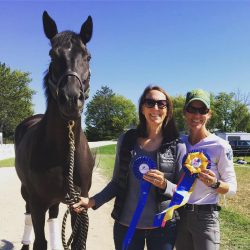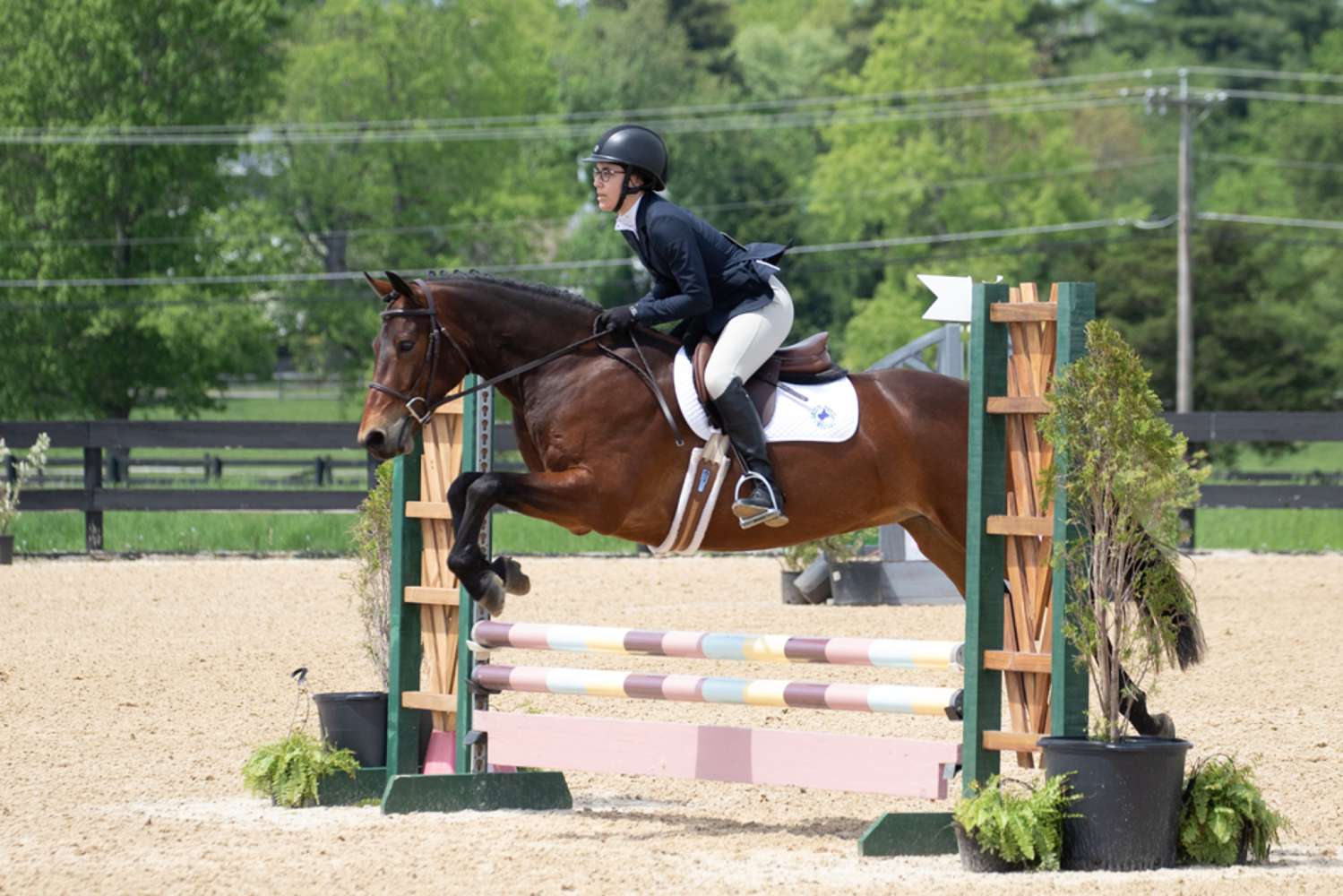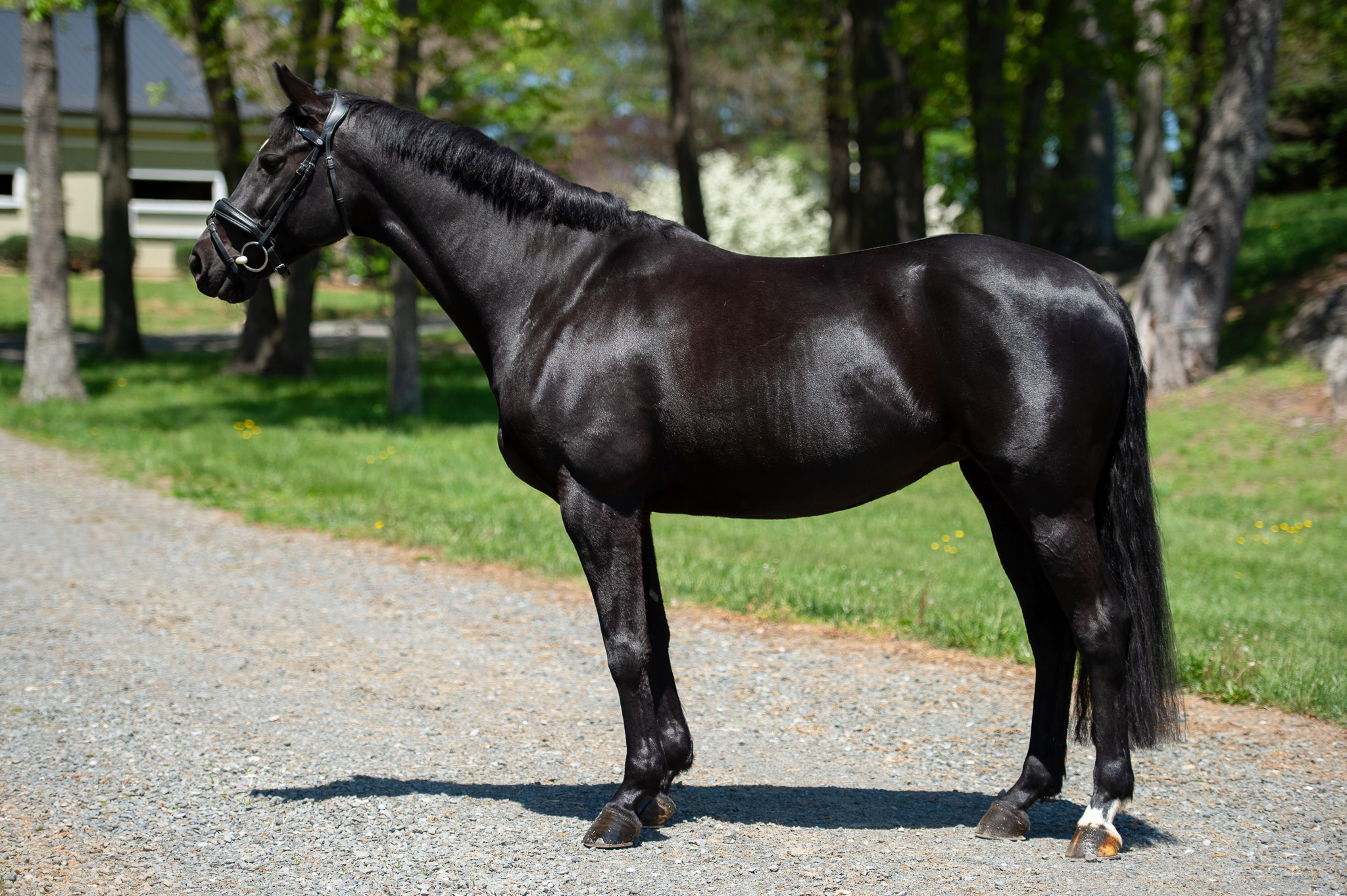In the market for a new four-legged partner? You may find your unicorn on our sister site, Sport Horse Nation. To help with the search, we’re going to feature a selection of current listings here on EN each week. We include the ad copy provided; click the links for videos, pricing and contact information.
On the 6th day of Christmas my true love gave to me … 6 Perfect Packers! There’s nothing more reliable than a packer. They’re as trustworthy as the day is long, ready to show you the way around cross country. Here are 6 tried-and-true lower level packers who are ready to come home with you for the holidays!

Jacob. Photo via Sport Horse Nation.
NOVICE PACKER, LOW LEVEL EVENT HORSE
2011 16’1 Grey OTTB Gelding, Jacob is a solid, safe low level event horse. Easy to get round. Steady to jumps. Easily ridden by amateurs. Used in lessons. Jacob is ready to be a child’s first horse or an amateur who wants a safe steady ride. Tons of training level competition experience and preliminary schooling, however he seems happiest at novice and below. Sweet and personable. No spook, rear or bolt. Trailers, clips, stands for farrier, etc. No vices. Price negotiable to great home. Located in Georgia.

Determined Again. Photo via Sport Horse Nation.
TALENTED NOVICE/TRAINING PACKER
Offered for sale is Determined Again, a 16 hand, 14 year old OTTB gelding. “Aspy” is as chill as can be, with quite the sweet personality! He is a fairly easy keeper, as he keeps his weight up well and doesn’t usually have maintenance other than supplements. No buck, rear, bolt, kick, or bite in this guy! Aspy has very fancy dressage, consistently scoring in the low thirties, and is a beast in cross country. More woah than go, but is not a kick ride or lazy by any means. Has schooled prelim cross country, and schools up to 3’9″ in lessons at home. He has his lead changes. Has been ridden and competed by a 15 year old for the past two years, and took her from starter to novice level recognized events and training level jumper shows. Aspy stands in cross ties, goes on hot walker, trailers great, stands for vet and farrier, and has no stable vices. Located in Nolensville, Tennessee, asking $ 15,000.

Blue days, Black nights. Photo via Sport Horse Nation.
Blue Days, Black Nights “G” TRAINING PACKER
Blue days, Black nights “G” is a 2008 16.2 hand thoroughbred gelding. G was proven to be unsuccessful in the track at a young age due to his lack of “enthusiasm” He is new to eventing with low miles. G has competed successfully through training scoring consistently in the low to mid thirties. He recently completed the Waredaca classic training three day event. G is currently being brought through the levels with a young rider. He is quiet, straightforward, and honest. He would be dream horse for an amateur rider wanting a trustworthy horse who is talented in dressage. He would also be very successful in the jumper world. G is located in Citra, Fl 20 minutes north of Ocala. He is priced at $15,000.
Contact Drew Cheek for more information:
[email protected]
(678)-684-7337

Sweet Georgia Brown. Photo via Sport Horse Nation.
WINNING Novice Packer!
Sweet Georgia Brown is a 14.2hh Mustang Gelding. He has evented through Training, consistently placing in the top 3 at BN and Novice events! He started competing at recognized horse trials in March of 2016 and qualified for the American Eventing Championships where he finished 3rd in the Junior Beginner Novice division with a rider in her first year of eventing as well. Immediately following, another junior rider took over his ride, competing him through Novice WINNING Area III Junior Novice Championships. Sweet Georgia Brown is an absolute pleasure to ride – especially to jump! Point, and shoot. This guy will carry you around a course. He knows his job, and absolutely loves it! Perfect for an Adult Amateur looking to stay at the lower levels and be very competitive, or a young rider that would like to move up the levels – he’s got plenty of scope with a high jump record of 4’9,” so far!
Sweet Georgia Brown also excels on the flat with 3 very correct, rhythmic gaits. He is schooling second level movements. He has schooled much of the Intermediate cross country course at Poplar Place and is absolutely game. When not competing and jumping the moon, Sweet Georgia Brown is an excellent lesson horse. He has taught beginner riders the basics and helped adult riders gain confidence jumping. Prior to 2016, he did a little of everything from being an adult riders dressage horse, teaching IEA kids to ride and jump, and being a family pony. He travels perfectly and stands quietly for the farrier. He also loves a long bareback trail ride in his halter alone, or with friends.
Super sound and has great feet. He can go barefoot or shod, depending on your preference. An easy keeper in every way. Up to date on all shots and coggins. Located in Georgia.

Quarter Irish. Photo via Sport Horse Nation.
Safe Scopey Novice Packer
Quarter Irish “Liam” is a grey 15.2 8 year old Appendix Quarter horse gelding. He looks like a small Irish horse, but he can easily compensate a larger rider as he has a big barrel! He has evented through novice with a junior rider, and competed at the AEC’s in 2017 after only 3 horse shows with no jumping/time penalties at beginner novice! He also qualified for the AEC’s in 2018, and is ready to move up to training now. Easily schooling 3’3 courses. Liam is kind and safe, with plenty of scope. He goes all three phases in a rubber snaffle. He is a careful show jumper and brave cross country as he loves to jump. He’s never had a show jumping rail or a stop at any obstacle. Fast and clean cross country coming in 30+ seconds below time going recognized novice, but doesn’t pull. No problems with ditches, banks, or water. Smooth and comfortable gaits on the flat, he learns quickly and puts in a great effort everyday. He’s currently schooling basic 1st level dressage. Quiet on and off property, and the same ride no matter turnout or frequency of riding. He’s gone to the beach, clinics etc without a problem. Liam could also excel in hunters (he has perfect knees!) or jumpers, and is ideal for an adult amateur or a young rider looking learn the ropes of eventing or hunters and jumpers! Easy keeper, and good for vet, farrier, clipping, and loading. Respectful and sweet on the ground, he loves being scratched and groomed, and will easily cross tie, ground tie or get tacked in the stall. He will stable away from home for horse shows or clinics with no stress. Liam has been in consistent training and is sound and ready to start the 2019 season with someone new! For sale as owner is starting college soon. He is currently at Hunters Haven Farm in Groveland, MA. Contact Hilda Ronn at (617)-763-7121 or at [email protected] for more information or videos. 22k.

Never Say Never. Photo via Sport Horse Nation.
The Perfect Pony – Novice Packer with Training Mileage
Never Say Never (Gina) is a 14yr old, 14h, POA/Quarter Horse who has successfully competed novice recognized and up to training unrecognized. Very steady in the dressage, jumps around the show jump with plenty of scope, and is brave and honest out on cross country. Would be the perfect pony for an ambitious, young eventer looking to learn the ropes of the sport on a safe, experienced pony. Loads, clips, stands for the farrier, bathes, etc.
I have had the pleasure of calling this pony mine for the past 5 and a half years and am only selling because I’ve outgrown her. Located in Michigan.
Recent shows:
-Kentucky Classique 2018: novice three day (long format) – 8th
-Champagne Run 2018: novice – 3rd
-Midsouth Pony Club 2018: novice – 3rd
-Maydaze 2018: novice – 4th
-Ocala International 2017: novice – 1st
-Rocking Horse Spring 2017: novice – 1st
Listings included in this article are randomly selected and confirmed to be current and active before inclusion. Sport Horse Nation features user-generated content and therefore cannot verify or make any warranty as to the validity or reliability of information.






















































